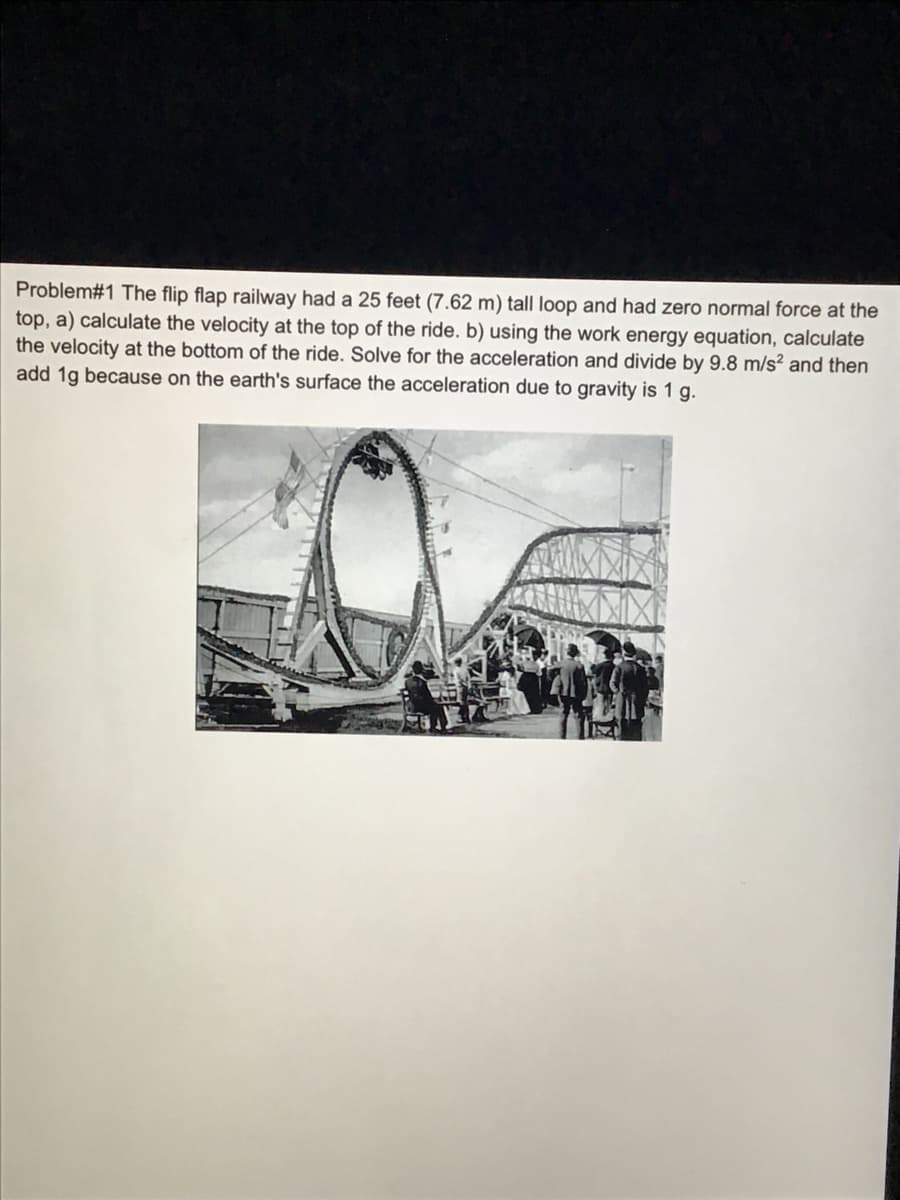Problem#1 The flip flap railway had a 25 feet (7.62 m) tall loop and had zero normal force at the top, a) calculate the velocity at the top of the ride. b) using the work energy equation, calculate the velocity at the bottom of the ride. Solve for the acceleration and divide by 9.8 m/s² and then add 1g because on the earth's surface the acceleration due to gravity is 1 g.
Problem#1 The flip flap railway had a 25 feet (7.62 m) tall loop and had zero normal force at the top, a) calculate the velocity at the top of the ride. b) using the work energy equation, calculate the velocity at the bottom of the ride. Solve for the acceleration and divide by 9.8 m/s² and then add 1g because on the earth's surface the acceleration due to gravity is 1 g.
Principles of Physics: A Calculus-Based Text
5th Edition
ISBN:9781133104261
Author:Raymond A. Serway, John W. Jewett
Publisher:Raymond A. Serway, John W. Jewett
Chapter6: Energy Of A System
Section: Chapter Questions
Problem 6P
Related questions
Topic Video
Question
100%

Transcribed Image Text:Problem#1 The flip flap railway had a 25 feet (7.62 m) tall loop and had zero normal force at the
top, a) calculate the velocity at the top of the ride. b) using the work energy equation, calculate
the velocity at the bottom of the ride. Solve for the acceleration and divide by 9.8 m/s? and then
add 1g because on the earth's surface the acceleration due to gravity is 1 g.
Expert Solution
This question has been solved!
Explore an expertly crafted, step-by-step solution for a thorough understanding of key concepts.
This is a popular solution!
Trending now
This is a popular solution!
Step by step
Solved in 3 steps

Follow-up Questions
Read through expert solutions to related follow-up questions below.
Follow-up Question
what about the last part? how many g's does the coaster experience? I calculate 6, but every story I've read about the Flip-Flap says 12 g's.
Solution
Knowledge Booster
Learn more about
Need a deep-dive on the concept behind this application? Look no further. Learn more about this topic, physics and related others by exploring similar questions and additional content below.Recommended textbooks for you

Principles of Physics: A Calculus-Based Text
Physics
ISBN:
9781133104261
Author:
Raymond A. Serway, John W. Jewett
Publisher:
Cengage Learning

Physics for Scientists and Engineers
Physics
ISBN:
9781337553278
Author:
Raymond A. Serway, John W. Jewett
Publisher:
Cengage Learning

Physics for Scientists and Engineers with Modern …
Physics
ISBN:
9781337553292
Author:
Raymond A. Serway, John W. Jewett
Publisher:
Cengage Learning

Principles of Physics: A Calculus-Based Text
Physics
ISBN:
9781133104261
Author:
Raymond A. Serway, John W. Jewett
Publisher:
Cengage Learning

Physics for Scientists and Engineers
Physics
ISBN:
9781337553278
Author:
Raymond A. Serway, John W. Jewett
Publisher:
Cengage Learning

Physics for Scientists and Engineers with Modern …
Physics
ISBN:
9781337553292
Author:
Raymond A. Serway, John W. Jewett
Publisher:
Cengage Learning

College Physics
Physics
ISBN:
9781285737027
Author:
Raymond A. Serway, Chris Vuille
Publisher:
Cengage Learning

College Physics
Physics
ISBN:
9781938168000
Author:
Paul Peter Urone, Roger Hinrichs
Publisher:
OpenStax College

College Physics
Physics
ISBN:
9781305952300
Author:
Raymond A. Serway, Chris Vuille
Publisher:
Cengage Learning